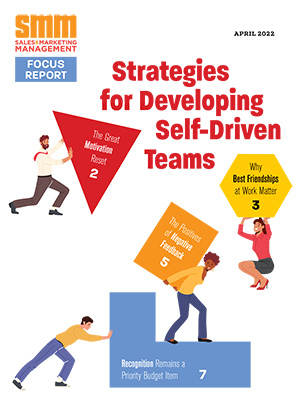Whether you’re talking about the global economy or technology, there’s no shortage of data on emerging trends to be found. Indeed, individuals and organizations are quite mindful of it.
Surprisingly, though, very little has been written about emerging trends in the sales profession. And make no mistake: There are plenty of trends in this space deserving of coverage. Professional sales training is now required, for one, as is the need for useful technology creating efficiency with customer relationships.
Beyond those, however, the world’s challenges are changing the very manner of selling. New issues await today’s professional. These trends require flexibility, tenacity, and the opportunity to educate ourselves in a variety of disciplines. To wit:
Global clients. Selling professionals are experiencing a cultural shift in their respective account bases. Over the course of nearly three decades, a dramatic shift from domestic client bases to a multinational one has taken place. Thus, it’s vital for all selling professionals to think globally and act locally.
The current economy is morphing faster than in the days of both immigration and the Industrial Revolution. We now do business with communities and nations we’d never heard of 10 years ago. Selling representatives must be cautious about words, dress, linguistics, and even electronic communication. Anything said or written can be misinterpreted. The 500 most commonly used words in the English language have over 14,000 definitions.
Tomorrow’s selling professionals must undertake the study of international cultures and languages. The acquired knowledge assists professionals to communicate articulately with global clients, which provides better relationships.
Gaining a better understanding of business etiquette, linguistics, mannerisms, and culture enables selling professionals to diminish barriers and gain better insight into client issues. Moreover, the ability to engage cross-culturally enables selling professionals to competition-proof their capabilities.
Knowledge management. Many years ago, computers were bulky monoliths performing minimal functions. Then, as now, computer operation required data. But as computer software developed, spreadsheets enabled end-users to take data and gain useful information, such as buying patterns and favored products.
And yet, with the emergence of smarter technology, usefulness of the Internet, and spontaneity of access, stored information has morphed into knowledge. In today’s selling world content is king.
Selling professionals require a wealth of knowledge to remain competitive. Tomorrow’s selling professional requires better insight into the customer’s world. Professionals must study competitors, the industry, and the client to help determine future needs. Using knowledge to help the customer remain competitive and offer provocative insights provides value and partnership. Customers engage with those they trust.
Direct relationship management. For years, customer relationship management was paramount to organizational success. As we all know, CRM is an information industry term for software, and usually Internet capabilities, that selling professionals and their organizations use to manage customer relationships. Databases, Windows-based software, and Internet applications all assist with maintaining client contact.
But while development has created wealth for software applications, it has done little for client relationships. Selling is a relationship business. Individuals want to conduct business with those they trust. Picking up the phone is more meaningful than sending an e-mail, and the more direct contact the better—people just aren’t that busy. In an increasingly competitive market, having direct contact will actually deflect competitive forces.
Strategic methods. In a recent research survey of over 400 sales managers, 87 percent admitted their professionals were too tactical. An understandable outcome, as selling professionals are tactical by nature. Nevertheless, tactics are not the best use of time and resources.
The new era requires selling professionals to become more strategic in their account management and account planning. The research professional of tomorrow requires a tenacious desire for research. Sellers will require comprehension of competitive forces, industry demographics, and changing political and economic areas, as well as technological changes.
Rather than simply selling vertical products and services, future account management requires applying the value proposition to the enterprise.
Driving force. A prevalent component of any business, big or small, is strategy. But important as strategy is, it cannot be implemented without driving force. Ultimately, this boils down to selecting products (or services) to offer and the markets in which to offer them.
Every selling organization will need to strategize and determine their driving force. Clients require new methods of service and support. Moreover, the need for proximity and speed of service will require representatives to be more responsive.
More importantly, managing account in silos and placing numerous impediments that create intra-selling competition hurts client relationships and destroys margins.
Talent. The diminishing labor pool and the constant drive for profits disables organizations’ capability to acquire the best talent. A frightening thought, for the largest asset of any organization is talent—especially sales talent. Nothing happens in an organization without someone’s selling something.
Simply put, talent management and sales effectiveness needs to be at the top of every manager’s list. Many have tried to achieve effectiveness through cuts in sales training, support staff levels, and so forth, but cold, hard figures expose the folly of such an approach. Just take a look at these statistics from CSO Insights’ 2009 Annual Sales Effectiveness Report:
• The percentage of salespeople failing to hit their sales quota rose from 38.8 percent to 41.2 percent.
• Overall revenue plan attainment dropped from 88.2 percent to 85.9 percent.
• Seventy percent of firms report the ramp-up time for new salespeople is seven months or greater.
Another facet of the talent issue: Despite the need for selling roles in every business, only a few dozen out of the more than 4,000 colleges and universities in the United States have an established a formal sales program. Astonishingly, research indicates up to 92 percent of sales employees in this country lack formal selling education.
Future sales leaders will require education acquisition. Simply put, selling is a profession and must be treated as such. Future leaders must engage in the proper education to increase proficiency and effectiveness. That said, training must not be event-based. The purpose for training is to decease ineffective tendencies and provide strengths. New habits manifest over months@#x2014;not hours in a classroom.
Customer service. According to Peter Drucker, an organization exists for one reason and one reason only: the customer. Unfortunately, the wrestlers of Wall Street persuade many firms to focus on irrelevant profits. Future organizations require more suitable strategic methods and driving force.
Fortifying organizational strategy requires sagacious attention to customers. Similar to sales, customers are the lifeblood of every organization. Competitive differentiation stems from the perceived customer value.
Customers desire to be with those they trust; this is the key differentiator in a marketplace cluttered with vendors. Appreciation from your greatest asset takes no time and little investment, and pays a huge return.
Customer service extends internally and externally and relies on people, processes, and physical evidence. Selling professionals and peers will need to employ a true customer orientation, from answering telephones to returning phone calls. Procrastination and avoidance will be grounds for termination as organizations attempt closeness with customers.
Also, processes must be efficient and client-friendly. Lengthy forms and waiting times only add frustration. Tomorrow’s leaders will constantly walk the process to eliminate tardiness and frustration.
Finally, customer service requires a clean act. Selling professionals will dress differently, act differently, and speak differently. Clients make decisions within the first 12 seconds. Ask what clients believe about the firm and its employees.
While change is good, it requires adjustment. The future of selling requires changes to keep pace with generational and cultural shifts creating behavioral changes in decisions. The selling representative of tomorrow must work efficiently and quickly to maintain the pace.
Failure of change leads to competitive elimination. These trends require you to not sit on your past, but rather, to begin creating a new future.
Drew J. Stevens, Ph.D., is the president of Stevens Consulting Group.
Emerging Sales Trends in the New Economy
Get our newsletter and digital focus reports

Stay current on learning and development trends, best practices, research, new products and technologies, case studies and much more.

